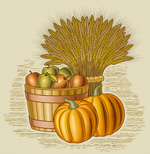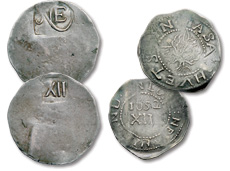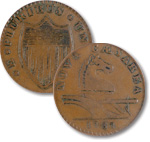Early American Coins
Early substitutes for money
Because coinage was very scarce in early New World settlements, European colonists used a variety of substitutes for money. Musket balls were assigned specific monetary value, and the colonists also adopted "wampum" used in trade by many Native American tribes. Wampum were beads made from clam, conch or similar light-colored shells. The beads were drilled so they could be strung on a leather thong for easy handling.

Commodity money consisted of products valued at specific rates for transactions.
"Commodity money" consisted of hunting, construction or farm products – and were known as "country pay." A bushel of wheat might be valued at 4 farthings, a bushel of Indian corn at 3 shillings, and a barrel of pork at 3 pounds. The most important commodity money in the South was tobacco – designated as official currency in the Virginia colony as early as 1619.
Hunting products used in commerce included beaver pelts, deer skins and moose hides – while construction products included iron nails and lumber, or a day's labor. Coinage remained so scarce during the Revolutionary War that commodity money was still widely used during the late 1770s and early 1780s.
Colonial coinage
The first old coins struck in the English-American colonies were the "NE" or "New England" coins authorized in 1652 by the Massachusetts General Court. These simple silver coins were punch-stamped with the letters "NE" on the obverse and the denomination in pence on the reverse ("III" or "VI" or "XII"). The simplicity invited clipping (cutting off pieces of the coins for the silver), and after a few months, these coins were replaced with more elaborate designs.

New England Shilling and Willow Tree Threepence coins
The Willow Tree Threepence displayed a tree in the center of the obverse, with rings of beads containing the inscription MASATHVSETS IN. Though struck until about 1660, all the coins bear the date 1652. After the Massachusetts mint switched from hammer striking to the rocker press, new Oak Tree coinage was produced from 1660-1667 and Pine Tree coinage from 1667-1682. But like the Willow Tree coinage, all Oak Tree and Pine Tree issues are dated 1652 (except for Oak Tree 2 pence coins, which bear 1662 dates).
(Please see America's First Coinage to learn more about Massachusetts Bay Colony coins.)
Other early American coins included Higley Coppers, struck in 1737 and 1739, and named for Samuel Higley, who mined copper on his Connecticut land and had the metallurgical skills to create steel dies for coinage. These coppers featured various inscriptions including VALUE ME AS YOU PLEASE and I AM GOOD COPPER.
Plans to replace depressed colonial paper currency with coins were proposed for Massachusetts in 1715, for Connecticut in 1739, and for all the English colonies in 1748. However, these proposals were not well conceived and none were implemented.
Foreign coins used in the colonies
While the American colonies accepted old coins from various countries when available, most British and European pieces went back to their issuing countries as payment for goods and services.
Spanish-American coinage became widely used in the English colonies. More than two dozen Spanish colonial mints in Mexico and South America struck large quantities of "Spanish milled dollars" – valued at 8 reales and often called "Pieces of Eight." Struck from silver unearthed or stolen in Spanish America, these 8 reales coins along with fractional ½, 1, 2 and 4 reales counterparts became the principal coins of the American colonists, and were the forerunners of the U.S. dollar and its fractional divisions.

Spanish 8 reales, also known as "Pieces of Eight"
In 1793, Congress demonetized all foreign coinage except gold coins of Great Britain, Portugal, France and Spain – and silver coins of France and Spain. This foreign gold and silver coinage remained legal tender in the United States until 1857.
Confederation-era coinage of 1783-1792
From the end of the Revolutionary War in 1783, until the establishment of the U.S. Mint in 1792, a variety of early American coins were issued by private minters and individual states. These old coins included a series of "tokens" (privately issued coins that circulated in public commerce) struck by silversmith John Chalmers of Maryland in 1783. Chalmers minted threepence, sixpence and shilling tokens all in silver. Several private issues of copper tokens as well as experimental coins for the Confederation were also minted from 1785-1787.
Robert Morris, Superintendent of Finance for the Confederation, submitted a plan to Congress in 1782 proposing a decimal-based coinage system based on a unit called a mill. The Morris plan could be used to convert foreign coins including Spanish milled dollars that held different value in the different states.
Thomas Jefferson of the Confederation's monetary committee believed the mill was too small in value. Jefferson proposed the dollar as the monetary unit – considering the widespread acceptance of the Spanish milled dollar – to be divided into tenths (dimes) and hundredths (cents). He also recommended coin denominations of ½, 5, 20, 25 and 50 cents. On July 6, 1785, Congress adopted Jefferson's decimal system with the dollar as the standard unit.
Coinage issued by individual states
Vermont was the first local American government to authorize a private mint to produce coins. The first design issued during 1785-1786 featured the sun rising over the Green Mountains with a plow in the foreground. The basic design of 1785-1788 Connecticut Coppers imitated the British halfpenny with the bust of a man wearing a laurel wreath. The reverse depiction of a seated Liberty resembled the British Britannia seen on halfpennies.

New Jersey state copper from 1787
New Jersey Coppers featured a plow beneath a horse's head, and Massachusetts Coppers introduced in 1787 were well received and stayed in circulation for several decades. While the Vermont, Connecticut and New Jersey mints were private operations, the Massachusetts mint was a state-run facility and the only local mint to adopt the 1785 federal resolution establishing a ratio of 100 cents to the Spanish milled dollar.
U.S. Mint pattern coins of 1792
When the U.S. Mint was authorized by Congress on April 2, 1792, many members of the House wanted to depict George Washington on the first U.S. coins. But the president rejected the idea as too monarchical, hence an image of the goddess Liberty was chosen instead. During 1792, several denominations of U.S. coins were struck in limited quantities and proposed to Congress and other governmental officials for consideration and approval.
These provisional or pattern coins included silver half dismes (half dimes) and silver dismes (dimes), "silver center cents" struck in copper with a small center plug of silver, and copper cents of the same size and design without the silver center. Much larger copper 1¢ coins, known as "Birch Cents," were struck from dies cut by engraver Robert Birch. A small quantity of quarter dollars, now extremely rare, were also struck in 1792.
Official U.S. coins debut in 1793
After more than 175 years of money substitutes like musket balls and beaver pelts...crude early coinage by the individual colonies and states...and broad usage of Spanish silver coins...the fledgling United States of America issued its first official coins for circulation in 1793. These half cents and large cents struck in pure copper would soon be followed by silver coins including half dimes, dimes, quarters, half dollars and dollars.

